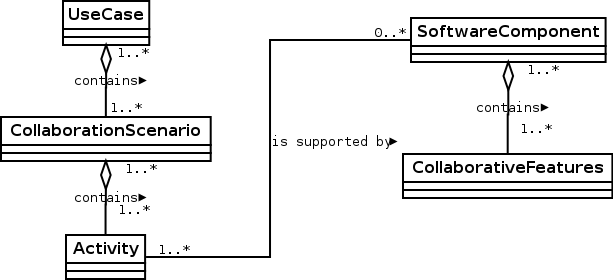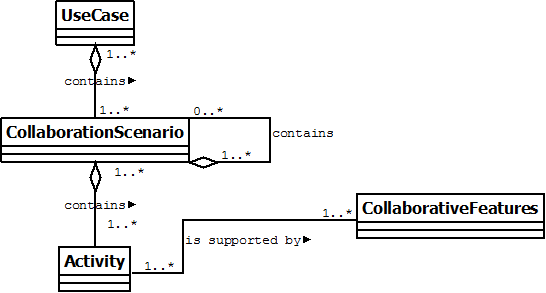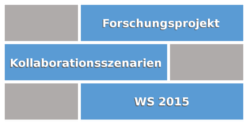At the beginning of the research project an own taxonomy for collaborative tasks was created. This taxonomy is based on a taxonomy that has been published by Schubert & Glitsch (2015) and the taxonomy of the aperto framework. The main idea of the taxonomy of the research project is to represent collaboration scenarios as a composition of multiple activities. A detailed description for the concept of activities can be found in the article for the aperto framework.
The following UML-diagram depicts the basic taxonomy designed by the research project that shows the relationships of different elements of collaborative tasks.

Taxonomy with SoftwareComponent
Activities are executed with the help of software components, which in turn provide the user with a set of collaborative features. The members of the research project decided to skip the level of software components for the classification of collaboration scenarios in order to look at the collaboration scenarios in a more general manner. By doing this the software specific implementation of collaboration scenarios is abstracted. The collaboration scenarios in the catalogue are only characterized by activities, collaborative features and the relationship between these two elements.
The actual classification of the collaboration scenarios is thus based on a new taxonomy, which additionally allows nesting of collaboration scenarios. This means that a collaboration scenario can consist not only of activities but also of further, subordinated collaboration scenarios. The next UML-diagram shows the taxonomy, that is a theoretical foundation for the entries in the catalogue:

Taxonomy of the catalogue
References
Richter, A. et al., 2012. aperto – Ein Rahmenwerk zur Auswahl, Einführung und Optimierung von Corporate Social Software M. Koch & F. Ott, eds., München: Forschungsgruppe Kooperationssysteme, Universität der Bundeswehr München
Schubert, P. & Glitsch, J.H., 2015. Adding Structure to Enterprise Collaboration Systems: Identification of Use Cases and Collaboration Scenarios. Procedia Computer Science, 64, pp.161–169


